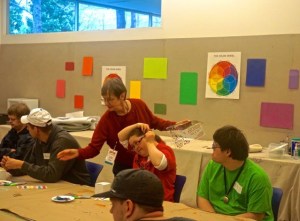The DMA has been a nationally recognized leader for more than a decade in the development of accessible programming for visitors with disabilities to connect with art. From our Sensory Days for visitors with autism, to our Meaningful Moments program for visitors with dementia, to Art Beyond Sight for visitors with vision impairment, our access programs foster creativity and learning, improve mood, and dramatically enhance quality of life. During this time when we’re all staying in, we asked our Manager of Access Programs, Emily Wiskera, to demonstrate an accessible, sensory-friendly art activity that you can do from home.
Sensory Ice Cube Painting
Materials needed:
Food coloring
Water
Ice cube tray
Paper
Optional materials:
Popsicle sticks or wooden dowels
Aluminum foil or plastic wrap
Newspaper or wax paper
Old shirt or painting smock to protect clothes from staining
Art projects are a great way to encourage learning through play. When kids are engaged in art making, they are also developing and practicing fine-motor, visual motor, and sensory motor skills. For some children, their level of engagement and participation improves when there is a sensory component to the activity. Children with autism demonstrate a range of sensory preferences and aversions. The activity of painting with ice cubes engages the senses and can be adapted to your child’s individual needs, whether they are a sensory seeker or sensory avoider. And it’s the perfect skill-building opportunity for a hot summer day!
Directions:

Add 2 to 8 drops of food coloring to each ice cube cup. Fewer drops will result in lighter colors. Encourage children to explore mixing primary colors together to make secondary colors: Red + Blue = Purple, Red + Yellow = Orange, Yellow + Blue = Green.

Fill each ice cube cup with water, allowing some space for the ice to expand.

For children who dislike getting messy or who avoid tactile stimuli, cover your ice cube tray with a sheet of plastic wrap or aluminum foil. Adults can use a knife to pierce a hole over each ice cube cup. Then, insert popsicle sticks through the holes in the foil and place in the freezer. Allow to freeze overnight.
Remove the ice cube tray from the freezer and allow it to sit on the counter for a few minutes before removing the ice cubes.

Place newspaper or wax paper over your painting surface, whether that is the kitchen table or outside on the sidewalk. Place the paper your child will paint on top of the protective paper. If taking this activity outside, children will have to paint quickly as ice cubes will melt faster.

Tips:
To keep children engaged, challenge them with achievable goals. Can they use all of the different colors? Can they draw three different shapes? Can they cover their entire paper with color?
For extended learning opportunities, involve your child throughout the process. Ask them to help you gather materials, squeeze the food coloring bottles, count the number of drops of food color squeezed into each cup, mix new colors, or count popsicle sticks.
Remember that the process of exploring materials and techniques is more important than the final product. If your child tends to feel too much pressure when making art, treat this activity as a science experiment.
Emily Wiskera is the Manager of Access Programs at the DMA.


































